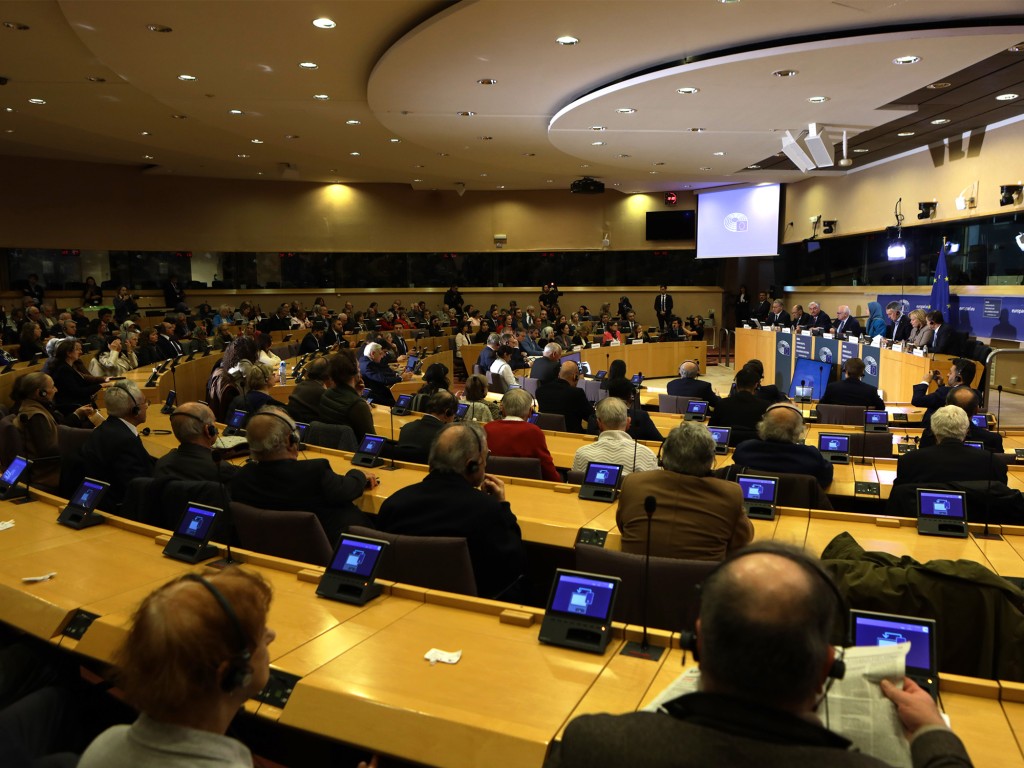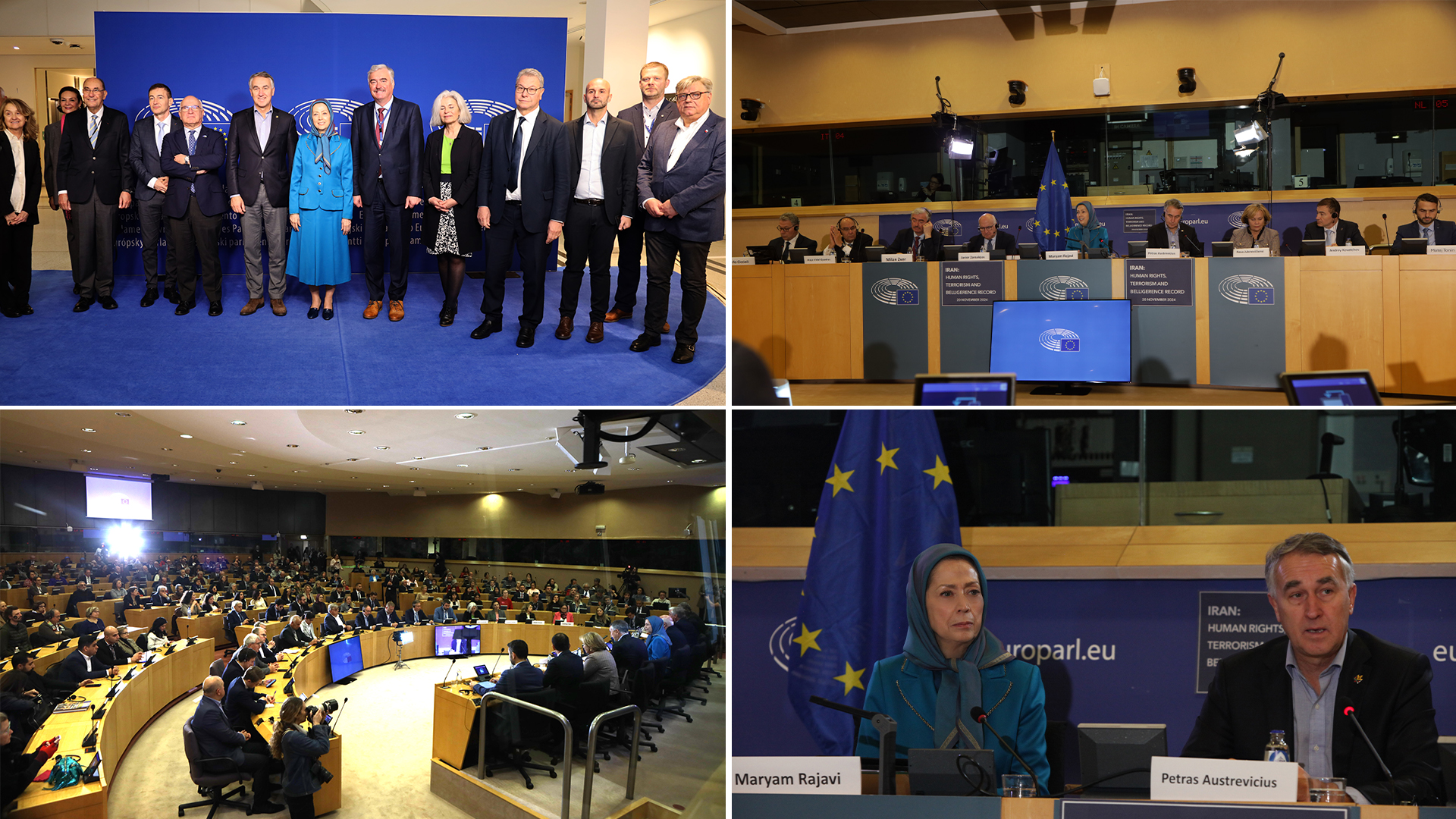Maryam Rajavi’s Remarks at the European Parliament

The Process of Regime Change in Iran, and the Role of Organized Resistance
It is a pleasure to be with you at the outset of this new term of the European Parliament. During the previous term, this Parliament passed two resolutions advocating for the designation of the Revolutionary Guard Corps (IRGC) as a terrorist organization. This was a vital opportunity to counteract the belligerence of the religious dictatorship governing Iran—a step that, unfortunately, was not taken.
Additionally, the activation of the snapback mechanism remained unaddressed. For decades, this regime has relied on exporting fundamentalism, terrorism, and warmongering as its primary strategy to suppress the Iranian people and thwart their uprisings.
What, indeed, was the crime of Professor Alejo Vidal-Quadras, the former Vice President of this very Parliament, who survived an assassination attempt in Madrid a year ago? His only ‘offense’ was standing firmly with the Iranian people and their legitimate resistance in the battle against religious fascism.
The Clerical Regime’s Record of 100,000 Political Executions
The war against the Iranian people has seen some 800 executions since the start of 2024, a figure that is both astonishing and deeply regrettable for a Parliament that has led the campaign for the abolition of the death penalty. It is equally painful for the Iranian people and their Resistance, which has advocated for its abolition in their program for the past 20 years.
Since the regime’s new president assumed office four months ago, approximately 500 individuals have been executed.
The clerical regime has a track record of 100,000 political executions, and over half a million tortured prisoners.
Supreme Leader Khamenei has repeatedly stated that if the regime does not engage in conflicts in Syria, Iraq, Yemen, Lebanon, and Gaza, it would be forced to defend itself in Tehran, Isfahan, and Shiraz—the heart of Iran.
The uprisings of 2009, 2017, 2018, 2019, 2020, and 2022 bear witness to the undeniable truth that the regime’s primary war is against its own people. Just a few hours ago, thousands of retired teachers and educators held a protest outside the mullahs’ parliament with chants of “Enough is enough! Stop this tyranny!”
It is not without reason that the regime has completely violated the nuclear agreement and, by resorting to every form of concealment and deceptive proposals and plans[1], continues its nuclear bomb project, which it considers a strategic guarantee for its survival. The long-overdue activation of the snapback mechanism and the six UN Security Council resolutions is the first urgent and necessary step. Nevertheless, the ultimate solution for getting rid of this evil dictatorship is regime change at the hands of the Iranian people and the Iranian Resistance.

Democratic Change is Attainable
Today, as I stand before the House of European Democracy, I declare, the warmongering and terrorism of this regime can be ended. Democratic change and overthrow are both achievable and within reach, driven by the Iranian people and their Resistance. This goal is not only attainable—it is within reach.
I will now highlight the key elements for achieving this goal:
1. The profoundly discontented and incensed populace, together with the Resistance Units leading the charge and the courageous women at their helm. The Resistance Units constitute the components of the Army of Freedom. Through their relentless efforts to dismantle the barriers of oppression, they embody the force for change and stand as the freedom fighters of Iran. During the Free Iran World Summit in June this year (2024), video clips showcasing 20,000 of their activities from across the nation were aired, making the extent of the movement visible to all attendees.
2. The People’s Mojahedin Organization of Iran (PMOI/MEK), with thousands of experienced cadres, represents a movement with a 60-year history of battling the dictatorships of both the Shah and the clerics, recognized by both friends and foes for its pivotal role. This book contains the names and particulars of 20,000 martyrs of the organization, whom the regime has declared its principal enemy. This is also the primary reason for the regime’s relentless demonization of our resistance. Ashraf-3 in Albania, home to a thousand heroic women and nearly 1,000 former political prisoners who were tortured under both dictatorships, serves as one of the key centers of this organization.
3. The National Council of Resistance of Iran (NCRI), a democratic alternative, is comprised of 457 members[2]
from diverse political backgrounds, with women constituting over half of its membership. Established 43 years ago in Tehran by Massoud Rajavi, it stands as the most enduring political coalition in Iran’s history. The Council champions a comprehensive agenda that promotes freedoms and women’s rights, autonomy for ethnic groups, equality between Shia and Sunni Muslims as well as other religious minorities, and the separation of church and state. It also advocates for the abolition of the death penalty and a non-nuclear Iran, consistently supporting peace initiatives in the Middle East. At great cost, this resistance was the first to reveal the regime’s secret nuclear activities and facilities in 2002.
4. Over the past four decades, the Iranian Resistance has organized the largest gatherings of Iranians abroad, a clear testament to its support within Iran. Among its supporters are the families and survivors of the 100,000 victims who sacrificed their lives for freedom. This support base also includes hundreds of thousands of political prisoners for the past 45 years. A diverse cadre of Iranian professionals abroad, organized across 320 associations within Iranian communities, plays a crucial role in laying the groundwork for a free and democratic Iran.
Operating independently and with financial self-sufficiency, the Resistance funds all its activities—from daily operations to communications, publications, gatherings, and a 24-hour television broadcast via five satellites—through contributions from its members and supporters both inside and outside Iran.
5. Global support for the 10-point plan of the Iranian Resistance for a free Iran was prominently declared at the grand gathering of Iranians in July this year. This support includes:
a) Statements from the majority of 34 legislative bodies across Europe and America,
b) Several Arab countries,
c) Additionally, a declaration signed by 137 former global leaders and 80 Nobel laureates advocating for the establishment of a democratic republic, emphatically stating that there is no place in Iran for either a religious dictatorship or a monarchy.
The Process for Transferring Power after the Overthrow of the Clerical Regime
Dear friends,
Regarding the future of Iran, I have consistently emphasized that our goal is not to seize power but to restore it to its rightful owners—the people of Iran and their vote. According to the NCRI platform, the process for transferring power after the regime’s overthrow consists of the following steps:
a) The establishment of a provisional government, which will be in power for a maximum of six months. The primary responsibility of this government will be to organize elections for a Constituent Assembly.
b) Once the Constituent Assembly is formed, the provisional government will step down, marking the completion of the NCRI’s mission.
c) Sovereignty will then be transferred to the people’s representatives in the Constituent Assembly, who will form a new government for a two-year term, tasked with drafting, approving, and conducting a referendum on the constitution of the new republic.
Allow me to point out three key points for reassurance:
First, the religious dictatorship and its supporters claim that there is no alternative. This is an outright lie. As I have previously mentioned, world people and leaders have already stood against this falsehood.
In addition, the mullahs argue that without them, Iran, Syria, or Libya would descend into chaos. This is the flip side of their claim that no alternative exists. When a viable alternative is present, there is no place for chaos. Millions of Iranians living abroad will return to Iran.
Third, they falsely claim Iran will be partitioned, but this too is a lie. During the uprisings, our fellow Kurds and Baluchis chanted, “From Kurdistan to Tehran, and from Zahedan to Tehran, I sacrifice my life for Iran.” They are seeking their rights, not secession.
The Policy Mistakes of the West over the Past Three Decades
Allow me to conclude by saying that the source of the policy mistakes regarding Iran over the past three decades has been the failure to recognize these very realities, as well as the alternative that has emerged from 46 years of resistance against the velayat-e faqih regime, which represents religious fascism. This has been a fight for the freedom and equality of both Iranian women and men.
I reiterate, as I have always done, “No to Compulsory Hijab, No to Compulsory Religion, and No to Compulsory Government.”
I would like to extend my congratulations to the new leadership of the European Union. I hope that by rejecting all forms of appeasement, the EU would undertake a decisive policy towards the mullahs’ terrorist and belligerent regime. Such undertaking will respect the desires of the Iranian people for regime change, the establishment of democracy and people’s sovereignty in Iran, and is a prerequisite to global and regional peace and tranquility.
I thank you very much.
[1] Ali-Akbar Salehi, State TV Channel 4, January 22, 2019: “Arak reactor has a core, which would include a set of calandrias and the fuel fits in these calandrias…. We had purchased similar calandrias, which I could not announce at the time. Only one person in the whole country knew about it, and we only told the Supreme Leader (Khamenei)…. The Supreme leader had warned us to be alert that they (the other parties) would violate their commitment. Therefore, we needed to pursue our objective with utmost cleverness, which meant that not only we did not demolish the bridges behind us, but instead we built new bridges so that if we were to go back, we could do it rapidly. Imagine these calandrias that are like pipes with 2-3 centimeters of diameter and 3-4 meters length. We had purchased similar calandria in the same numbers needed. We were told to pour concrete in the calandria [that was removed from the core], which we said sure and we did pour concrete… But we did not tell them that we have identical calandrias, because if we did, they would then ask us to pour concrete on those ones too. We now have those calandrias (laughing).
[2]The number of NCRI members presently stands at 457, not accounting for the deceased members and several members who are hostages at the hands of the regime.
Meetings and talks with MEPs on the sidelines of the conference: A new policy on Iran- Focused on its people and resistance
Meetings and talks with MEPs @KosmaZlotowski, @arekmularczyk, Andrey Kovatchev, @MEPNicolas, Pekka Toveri, @MilanZver, @petras_petras, @r_czarnecki, Benoît Piedboeuf, @VidalQuadras on the sidelines of the Conference: A new policy on #Iran– Focused on its people and resistance… pic.twitter.com/s8MhaWnu35
— Maryam Rajavi (@Maryam_Rajavi) November 26, 2024
- Tags: Human Rights, mullahs' regime, Terrorism, warmongering

